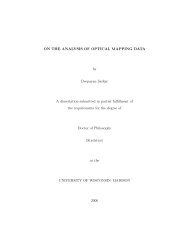Practical Considerations in Raking Survey Data
Practical Considerations in Raking Survey Data
Practical Considerations in Raking Survey Data
You also want an ePaper? Increase the reach of your titles
YUMPU automatically turns print PDFs into web optimized ePapers that Google loves.
and the sample of children with special health care needs identified <strong>in</strong> the screened households to<br />
form weighted control totals for age, sex, and race and then use those <strong>in</strong> rak<strong>in</strong>g the detailed<strong>in</strong>terview<br />
weights. This method ensures that the survey analysts do not ask why the age<br />
distribution of children with special health care needs from the screener sample does not agree<br />
exactly with the distribution <strong>in</strong> the detailed <strong>in</strong>terview data. Some caution needs to be exercised <strong>in</strong><br />
us<strong>in</strong>g this approach when the screener shows survey evidence of false positives.<br />
13. Rak<strong>in</strong>g to Control Totals Expressed as Percentages and Rak<strong>in</strong>g with No “Input” Weight<br />
Frequently, the user work<strong>in</strong>g with a weighted or an unweighted sample needs to weight it to fit<br />
marg<strong>in</strong>al population proportions. As an example (Table 3), the authors created an 11-case sample<br />
data set that conta<strong>in</strong>s two variables: VAR1, which takes values 1, 2, and 3 with frequencies<br />
27.27%, 45.45% and 27.27%, respectively; and VAR2, which takes values 1 and 2 with<br />
frequencies 45.45% and 54.55%, respectively. The objective was to weight this sample so that the<br />
distributions of VAR1 and VAR2 met the population distributions --- (20%, 35%, 45%) and (60%,<br />
40%), respectively --- with<strong>in</strong> a tolerance of 0.001%.<br />
14. Weight Trimm<strong>in</strong>g and Rak<strong>in</strong>g<br />
Weight trimm<strong>in</strong>g refers to truncation of high or extreme weight values <strong>in</strong> order to reduce their<br />
impact on the variance of the estimates, especially for subgroup estimates. One consequence of the<br />
truncation of high weight values is that the weights of the entire sample will not add to the<br />
population size. Although weight trimm<strong>in</strong>g is a separate topic from rak<strong>in</strong>g; they are certa<strong>in</strong>ly<br />
related <strong>in</strong> the sense that weight trimm<strong>in</strong>g typically takes place at the last step <strong>in</strong> the calculations,<br />
which is often rak<strong>in</strong>g. Many large surveys use weight trimm<strong>in</strong>g (Sr<strong>in</strong>ath 2003, Abt Associates<br />
memorandum). Its objective is to reduce the mean squared error of the key outcome estimates. By<br />
22
















